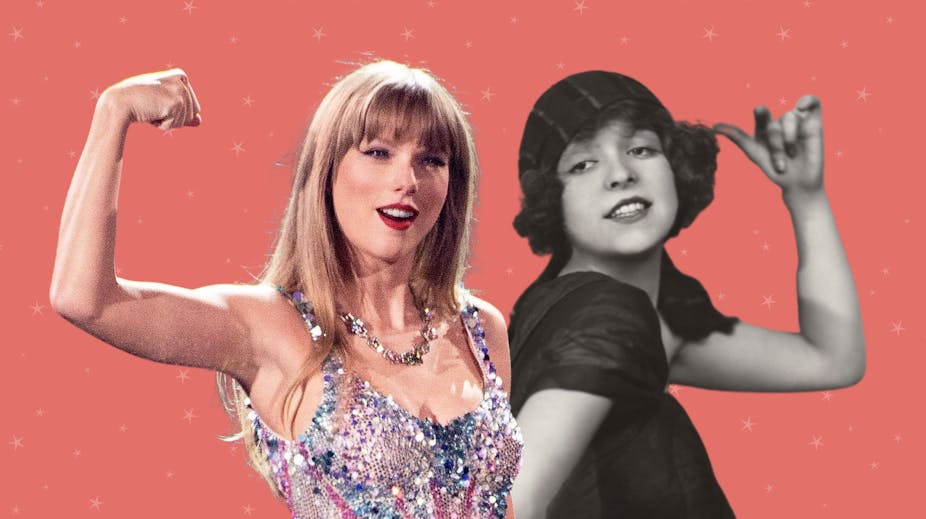While on stage collecting the award for album of the year (her fourth to date) at the 2024 Grammys earlier this month, Taylor Swift announced her 11th album: The Tortured Poets Department.
Moments later, Swift uploaded full details of her new record to Instagram, including the album artwork and track list. One of the 17 newly revealed tracks is titled Clara Bow. Actress Clara Bow (1905-1965) was the original “It girl”. And she had plenty in common with Swift. Adored and villainised throughout her career, her love life was constantly under scrutiny.
While news outlets instantly set about reporting on the excitement of Swift’s latest album, unveiling her new collaborations and praising her record-setting evening, an opposing maelstrom of hate was already on its way.

This article is part of Quarter Life, a series about issues affecting those of us in our twenties and thirties. From the challenges of beginning a career and taking care of our mental health, to the excitement of starting a family, adopting a pet or just making friends as an adult. The articles in this series explore the questions and bring answers as we navigate this turbulent period of life.
You may be interested in:
Valentine’s Day: research-backed tips for dating app success
Online dating fatigue – why some people are turning to face-to-face apps first
Love Island – what the show can teach young people about commitment
Headlines branded Swift “disrespectful” and “classless” for appearing to snub music legend Celine Dion. SZA fans accused Swift of robbing SZA’s SOS of album of the year. Twitter users called her “disgusting” for bringing her friend and collaborator Lana Del Rey on stage, after she’d lost out on her own award.
The tempestuous response to Swift’s win and subsequent album announcement is a reminder of the constantly fluctuating love/hate relationship with the media that has persisted throughout her career.
While their backgrounds could not be more different, there is a clear experience that both Bow and Swift have shared: unrelenting scrutiny overshadowing their hard work and success.
Who was Clara Bow?
Clara Bow was an American silent and early sound film actress, whose tumultuous career spanned from 1922 to 1933. Bow’s best-known film, the 1926 silent romantic comedy It, secured her status as a cultural icon who embodied the youth and liberation of the 1920s’ flapper.
Bow’s rise to stardom is often framed as a variation on the Cinderella tale. An unassuming girl, brought up in the poverty-stricken tenements of Brooklyn and longing for a chance in the limelight, wins a contest and is catapulted to screen stardom. But that’s not the full story.
This sequence of events, which kick-started the ongoing mythicisation of Bow’s star image, skips over the work Bow herself put in. It erases the labour involved in starting and maintaining her own career. In fact, Bow’s life is bound up with misinformation, speculation and tales of exploitation, abuse and illicit love affairs.
How Clara Bow inspired Taylor Swift
During the height of her career, Bow’s love life was a point of constant ridicule in popular film fan magazines. Headlines branding her “empty hearted” and asking “why can’t the It Girl keep her men?” sought to psychoanalyse her broken engagements. The press labelled Bow an “idiot”, and wondered why “no man [had] led her to the altar”.

Bow’s reputation as a “girl who burns ‘em up and then leaves ‘em cold” was exacerbated even further when in 1931, she found herself embroiled in scandal.
At the time, information about the marriages and divorces of celebrities, as well as suggestions of extramarital affairs and sex scandals, were commonplace in the press.
Bow’s assistant and best friend, Daisy DeVoe, was accused of trying to embezzle money from her. A reporter colluded with DeVoe to accuse Bow of: “Promiscuity and exhibitionism, kinkiness and incest, lesbianism and bestiality, drug addiction and alcoholism, venereal disease and family insanity.” They then tried to blackmail the actress, asking for USD$25,000 (£19,839) to cease printing the stories.
Before the trial, it was alleged that DeVoe had warned Bow: “I’ve got some letters and telegrams that that won’t do you any good if I turn ‘em over to the papers”. The reporter responsible for the blackmail received an eight-year suspended sentence and a fine for defaming her. But the trial had already done significant damage to Bow’s image.
In 2017, I visited the Margaret Herrick Library in Beverly Hills, which holds Academy of Motion Picture Arts and Sciences archive. During my research trip, I was able to access the papers of Clara Bow, as well as those who knew her: including notable gossip columnist Hedda Hopper.
Within the archive, there is a letter from Bow to Hopper, revealing her desire to someday write the story of her life – a potential attempt to set the record straight and reclaim the narrative that other people had created. Unfortunately, Bow died before she was able to do so.
Perhaps Swift’s ode to Bow will offer some artistic justice for the often-misrepresented starlet. Or perhaps it will lament Swift’s own inability to control the media narrative. We will find out soon. But it’s not hard to see why Taylor Swift, a modern starlet whose every move is scrutinised and criticised, would find a rich seam of inspiration in the life of Clara Bow.

Looking for something good? Cut through the noise with a carefully curated selection of the latest releases, live events and exhibitions, straight to your inbox every fortnight, on Fridays. Sign up here.

